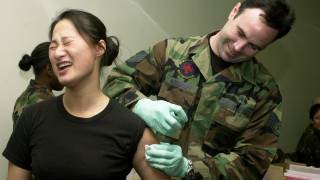15 Active Mumps Outbreaks Reported at US Immigration Facilities

According to a Centers for Disease Control and Prevention (CDC) announcement, there are 15 ongoing mumps virus outbreaks located in various U.S. Immigration and Customs Enforcement (ICE), Health Service Corps (IHSC) or local health departments.
As of August 29, 2019, these mumps outbreaks were reported in 7 states, and ‘new cases continue to occur in these immigration detention facilities.’
The mumps virus is easily spread by droplets of saliva or mucus from the mouth, nose, or throat of an infected person, usually when the person coughs, sneezes or talks. Complications include inflammation of the testicles, inflammation of the brain, meningitis, and deafness, says the CDC.
Over the past year, from September 2018 to August 22, 2019, a total of 898 adult migrants detained in 57 government facilities were listed as confirmed/probable mumps cases in 19 states.
In response to these mumps outbreaks in 19 states, ICE has delivered more than 25,000 doses of the measles-mumps-rubella (MMR) vaccine in these affected facilities.
The mumps virus is easily spread by droplets of saliva or mucus from the mouth, nose, or throat of an infected person, usually when the person coughs, sneezes or talks. Complications include inflammation of the testicles, inflammation of the brain, meningitis, and deafness, says the CDC.
ICE spokesman Bryan Cox said to AP News, ‘medical professionals at detention facilities screen all new detainees within 24 hours of their arrival to ensure that highly contagious diseases are not spread.’
Cox also said ‘detainees come from countries where communicable diseases are less controlled than in the USA and carry with them the risk of spreading infection.’
Some of these mumps cases may have originated from Central American countries such as Honduras, which announced significant mumps outbreaks during 2018.
Previously, on June 14, 2019, federal immigration authorities confirmed about 4,276 individuals were in medical quarantine in 39 detention centers, related to large numbers of mumps and chickenpox cases.
According to the CDC, a large portion of the mumps cases have been confirmed in Texas.
The Texas Department of State Health Services (DSHS) raised the alarm in December 2018, followed by 6 other state health departments in early January 2019, prompting what the CDC report calls “a coordinated national outbreak response.”
Due to a high vaccination rate in Texas, the number of mumps cases has been traditionally low, says DSHS. In 2017, only 470 cases of mumps were reported in Texas.
This new CDC report focused on the mumps virus and said detention facilities follow vaccination guidance from state and local health departments.
“To have this many mumps cases concentrated in this relatively small population is distinctly unusual in the United States,” said Dr. Jody Rich, Professor of Medicine and Epidemiology at Brown University and a volunteer with Physicians for Human Rights.
“We should be vaccinating all at-risk people as early as possible, particularly if we are about to confine them in a closed space, with a bunch of other unvaccinated people in the setting of an outbreak,” said Dr. Rich.
The CDC vaccination schedule is modified periodically (May 2019) based on changing Advisory Committee on Immunization Practices recommendations, logistics, or availability.
Routine vaccination of U.S.-bound refugees is strongly recommended and offered overseas to protect the health, prevent travel delays due to disease outbreaks. And for children, these vaccinations enable more rapid integration into schools after arrival in the USA.
As an example of Texas being proactive, the DSHS launched Operation Lone Star for its 21st year in July 2019. This no-cost program delivered approximately 43,000 health services and vaccinations to 9,346 people in southern Texas during 2018.
Another source of these mumps outbreaks may be the MMR vaccine’s long-term effectiveness.
According to a Harvard study in 2018, the MMR vaccine-derived immune protection against mumps persists on average for just 27 years, after the last administered vaccine dose.
In response to this vaccine-waning information, the CDC released new guidance suggesting when the 3rd dose of a mumps vaccine is appropriate to administer.
Nationwide, from January to July 19, 2019, the CDC has confirmed mumps infections in 1,799 people, living in 45 states and the District of Columbia.
Which is actually good news, when compared to previous years.
From January 2016 to June 2017, health departments reported 9,200 mumps cases, including outbreaks at schools, universities, athletics teams and facilities, church groups, workplaces, and large events.
CDC officials say 'it's never too late to be immunized.'
In the USA, there are 2 approved mumps vaccines, MMR-II and ProQuad. Commerical pharmacies in Texas, such as Brookshire's Grocery and United Supermarkets offer these mumps vaccines.
Note: Any vaccine can cause side effects, which should be reported to a healthcare provider, or the CDC.
Published by Precision Vaccinations
Our Trust Standards: Medical Advisory Committee


























